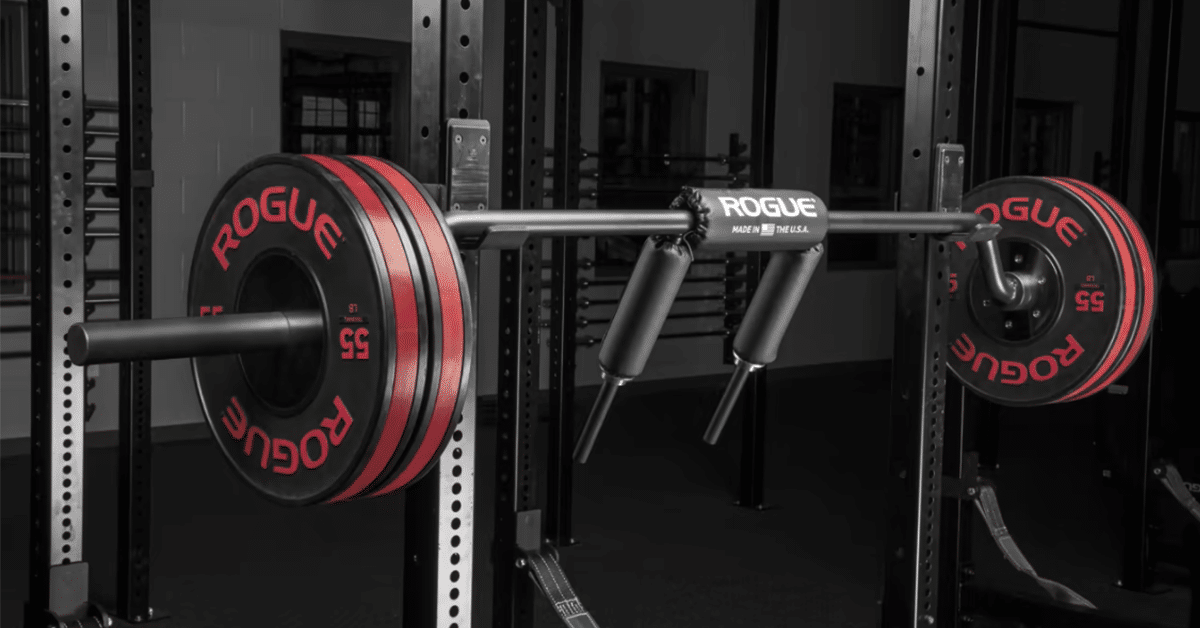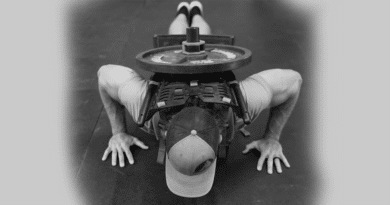Best Safety Squat Bar Guide – What it Does, Where to Buy and Why it’s Worth it
The Safety Squat Bar is a hugely valuable addition to any Box, gym or garage gym.
In this article we will explore, in depth, exactly what it does, how to use it, where to buy the right one and why it’s worth it.
For your convenience, click the button below to see our favourite choice for Box owners, Gym owners and home garage gyms.
Let’s start with a perspective from the famous strength coach Jim Wendler on this piece of fitness equipment.
“Of all the different specialty bars on the market, this is the one I recommend most.
The … bar develops great brute strength. It’s a phenomenal way to build your lower back, legs, and upper back. The key is to not get too fancy with it.”
What is a Safety Squat Bar?
A Squat Safety Bar is a barbell with a camber on each end (the collars are lower than the middle of the bar).
It has handles that stick out in front of the bar and can be easily gripped. This allows for the shoulders to maintain a stress-free position at all times instead of being pulled back behind the bar during the Squat range of motion.
- What is a Safety Squat Bar?
- What Does the Safety Squat Bar do?
- What are the Benefits of Safety Squat Bars?
- Are Safety Squat Bars Worth it?
- It is Easier to Squat with a Safety Squat Bar?
- How Much Does the Safety Squat Bar Weight?
- What’s the Best Safety Squat Bar to Buy?
- Rogue Safety Squat Bar
- Safety Squat Bar Technique
- Can you Front Squat with a Safety Squat Bar?
- Good Mornings with the Safety Bar
- Why was the Safety Squat Bar Invented?
- Who is the Safety Bar Good for?
- Safety Bar Squat vs Front Squat
- Mobility
- How to Program
- Learn More
What Does the Safety Squat Bar do?
- It allows lifters to ensure a high training effect while using lower absolute loads
- It enables shoulder mobility to become a non-factor for the Squat
- It naturally creates better pelvic orientation and bracing mechanics in most lifters
- It can be used to address weaknesses in the squat, such as the chest fall pattern
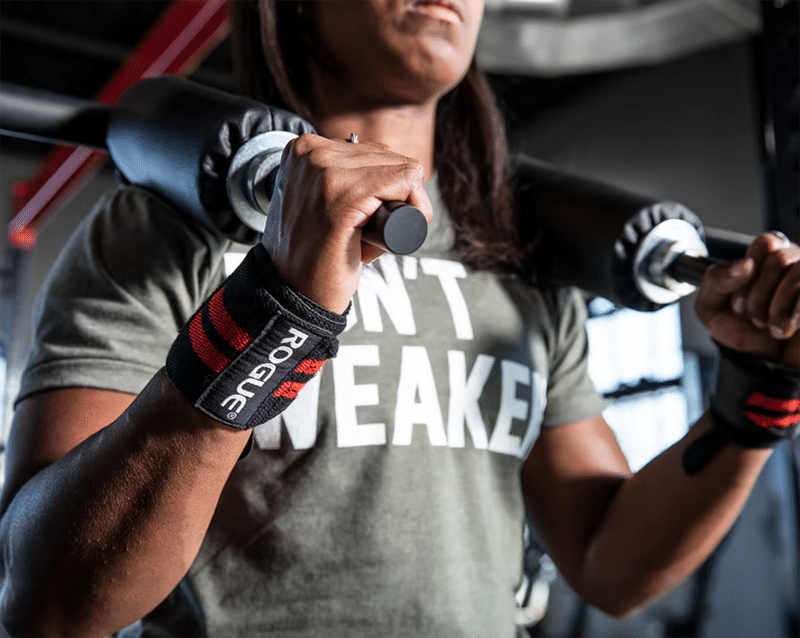
What are the Benefits of Safety Squat Bars?
When you Squat with the Safety Squat Bar, the weight becomes cambered out in front of you.
This makes you feel like it will dump you forward during the movement. This forces you to use your entire back to keep it steady and maintain good posture.
Because of the camber of the bar, this feels like doing a front squat without the fear of losing the bar forward.
Also, the padding and design of the barbell make it very easy on your shoulders. You don’t have to externally rotate your shoulders at all so it’s a great way to add volume to your squat training without the shoulder discomfort.
If you or any of the athletes in your gym have shoulder, wrist, hand or rotator cuff injuries then the Safety Bar is perfect.
The same applies for people suffering from elbow tendonitis or athletes that cannot properly move into the low bar squat position.
The Safety Bar is loaded behind and below your neck like the back squat.
This means that less thoracic extension and natural hand positioning is required to hold the bar.
This simplification allows you to concentrate more on important technique ques like pushing through your mid foot and hitting correct squat depth.
Less to think about. Improved confidence. Better lifts.
Are Safety Squat Bars Worth it?
Simple answer, yes.
It is Easier to Squat with a Safety Squat Bar?
Hecker and colleagues (2019) found that in competitive powerlifters, the Safety Bar placed less stress on the lower back than the traditional back squat. For those with back problems, the safety bar squat might be a better choice
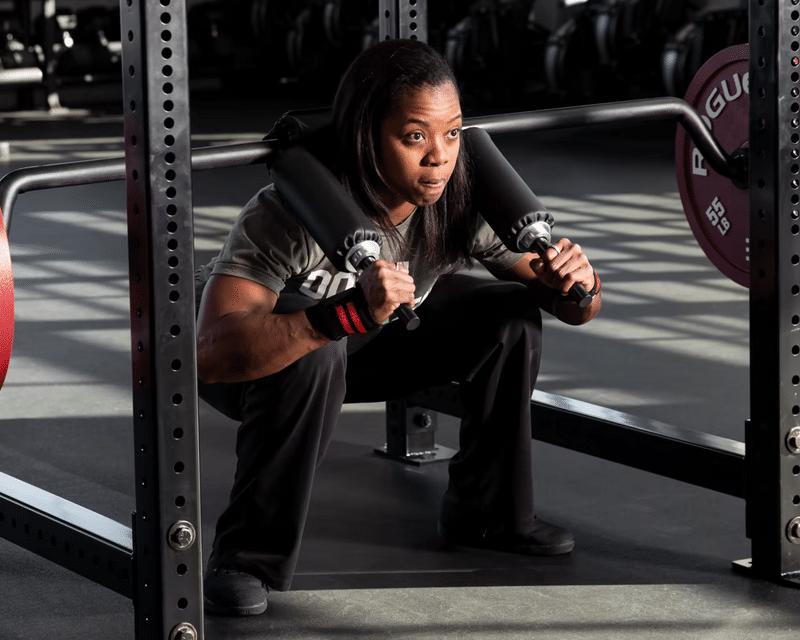
How Much Does the Safety Squat Bar Weight?
An average safety squat bar will weigh between 20kg (44lbs) and 32kg (70lbs).
The average size is somewhat heavier than a standard comparable Olympic 20kg (44lb) barbell.
Often, higher quality bars with higher weight capacities will be larger and/or heavier.
What’s the Best Safety Squat Bar to Buy?
The Rogue Safety Squat Bar is the best bar to buy because it sits at the perfect crossroads between value, quality, excellence, durability and performance.
Rogue Safety Squat Bar
The weight distribution is unique to this bar.
Training with the Rogue Bar is known to tax your anterior chain; the weight distribution falls between the front squat and the high-bar back squat to vary your power output training.
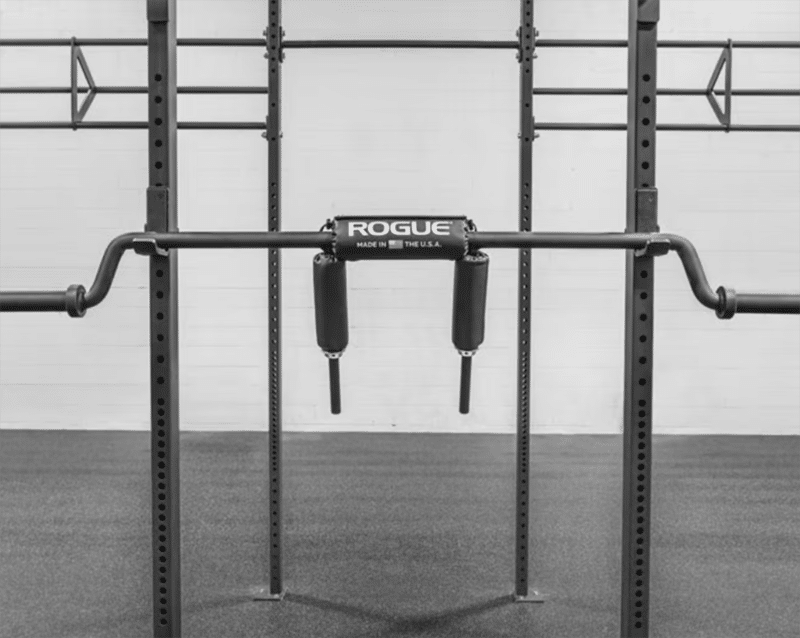
This bar is a safer option for intense squat progressions or maximum load lifts.
The Rogue Bar is known to increase your maximum working weight when compared to the traditional back squat.
Important: For Collars that fit specialty bars like the SB-1, please see the Rogue Proloc™ 1 Magnet Collars.
Specifications:
- Weight: 70LB
- Black Cerakote Finish
- 1.5″ diameter formed solid steel shaft
- 1″ diameter formed solid steel handles
- Machined Olympic sleeves
- Fully welded design
- Heavy duty vinyl and closed cell foam pads
*Cerakote has an excellent resistance to corrosion, but metal-to-metal contact, particular on the sleeves, can still cause wear over time.
Safety Squat Bar Technique
Place the pad on your back as close as possible to the low bar position – just below the spine of the scapula.
Hold the handles and try to maintain the angle on your forearm for the duration of each rep.
Don’t let your upper back round – fight to maintain thoracic extension as you reach back with your butt.
Your torso will be fairly vertical using this bar, compared to the low bar squat, therefore less involvement of the posterior chain muscles.
Can you Front Squat with a Safety Squat Bar?
Yes. The trick is to simply turn the Safety Bar around so the handles are facing you.
This method has helped many strongmen and powerlifters with mobility issues due to their size.
It allows them to continue to incorporate front squats into their training.
The Safety Bar variation allows these larger athletes to train the front squat without having to get into an uncomfortable front rack position that might occur with a traditional barbell.
Safety Bars are usually padded which helps to relieve discomfort that might incur from the use of a standard Olympic barbell.
One can assume that being comfortable during training would lead to higher repetitions and percentages since needed to stop from discomfort or a choking sensation is less likely to occur.
The padding can also be useful for athletes who still need to train the front squat but are recovering from shoulder injury.
This bar distributes pressure from the bar over a greater area, allowing spot specific pain to be mitigated.
Taking care of your body while being able train the front squat is a win-win.
Good Mornings with the Safety Bar
As for the good morning, it’s one of the best assistance exercises for your deadlift.
Few exercises do a better job of training the lower back and hamstrings.
The Safety Bar is ideal for Good Mornings as it also works the hell out of the upper back during the movement; an added component you don’t get with the straight bar.
Why was the Safety Squat Bar Invented?
The actual inventor was Jesse Hoagland, a new Jersey inventor who first brought the Safety Bar to the public’s attention in 1984.
Who is the Safety Bar Good for?
Let’s once again turn to Jim Wendler, “I also used this bar for athletes who had shoulder, wrist or hand injuries.
Besides the aforementioned squats and good mornings, we also used it for Hise Shrugs – one of the few upper body movements we could do with the injured athletes.”
Safety Bar Squat vs Front Squat
The Safety Bar Squat and Front Squat actually have a number of similarities when it comes to the muscle groups they target, and the intention for which they’re used for.
While these exercises shouldn’t be used interchangeably for athletes competing in Olympic Weightlifting, the Safety Bar Squat and Front Squat can both develop the strength and hypertrophy of your legs very effectively when programmed correctly.
Balancing
Having to maintain the barbell on the front of your shoulders during a front squat is probably the most challenging part of the exercise — not the actual work on your legs.
This is something that many athletes struggle with. Front rack mobility must be trained in the vast majority of athletes.
Since the bar can be lost off the shoulders when the lifter’s upper back strength or endurance is lacking, the Front Squat tends to use lighter loads.
Design
In addition, the design of the Bar allows the lifter to actually lift their hands off the handles completely (provided the handles are in a neutral position) and the barbell still won’t move.
Now, this is not to say that’s how you should use the safety bar. I’m only noting this so you understand the safety bar squat is significantly easier to balance on your shoulders without unwanted movement.
Angles of Movement
In the Safety Bar Squat and Front Squat, the differences in knee and hip angles are fairly minimal.
For this reason, there is little difference in how much work the lifter’s legs must do to lift the weight.
Trunk Muscles
However, there is a substantial difference in the trunk muscles required between the two.
For example, the barbell passively rests on the lifter’s shoulders during the safety bar squat.
Unless they’re driving the handles up deliberately, the trunk muscles are firing generally to keep the lifter upright.
However, the Front Squat demands active thoracic extension throughout the exercise — especially on the ascent.
Back Strength
The position of the barbell on the front of the lifter’s shoulders gives them no opportunity to rest because the bar would roll out of their front-rack position and the rep would fail.
Because of this, the Front Squat uses a greater amount of back strength and endurance to perform.
Mobility
The wrist, shoulder, and upper back mobility required to establish the front rack position make the Front Squat a fairly demanding exercise to perform — at least as far as mobility goes.
On the flip side, the design completely eliminates the required shoulder mobility in the traditional back squat.
This makes the safety bar squat a fantastic squatting variation for those with limited upper-body mobility.
How to Program
Take this advice from Powerlifting Technique about how to program the exercise into your training.
“Hopefully you are convinced by now that Safety Squats would be of benefit for you, so let’s now look at some general programming principles for how to apply these within your training.
As I mentioned, I typically find that athletes can perform somewhere between 87.5-90% of their low bar squat 1RM when using the Bar.
Fortunately, this is now backed by research, as a study in 2019 found that on average competitive powerlifters squatted 11% less using the Bar.
As for when and how to program them, there really isn’t any right or wrong answer.
I have programmed them as the primary squat day movement or as the secondary/tertiary day variation.
I have some lifters who do Safety Bar Squats year-round, as they can only tolerate one heavy low bar squatting day a week.
I have also programmed them with a pause or tempo to not only provide the benefits of the Safety Bar mentioned above, but also that of a pause or tempo.
The when and how is really going to be lifter dependent and based on their response to training with Safety Squats.
A Safety Bar is also a great tool for accessory movements as well.”
Learn More
Find out which Bar is right for you.

